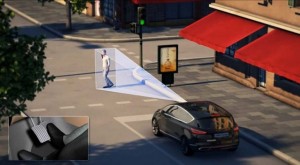
Toyota and Ford are among the many makers working on systems designed to prevent pedeestrian collisions.
With pedestrian fatalities taking an unexpected rise in recent years, automakers are looking for ways to not only reduce the death toll but quite literally steer clear of pedestrians in the first place.
Both Toyota and Ford this week unveiled new high-tech systems designed to detect when someone might walk in front of a vehicle and take steps to prevent a collision, or at least mitigate the impact.
The new Toyota Pre-collision System, or PCS, uses onboard sensors to scan the road ahead of the vehicle, issuing an alert if there’s a risk of a collision. But, the maker says, “If the likelihood of a collision increases, the system issues an audio and visual alarm to encourage the driver to take evasive action, and the increased pre-collision braking force and automatic braking functions are activated.”
Ultimately, if the driver does not react in time, the vehicle will automatically attempt to steer away from the pedestrian.
Ford demonstrated a similar concept earlier this week in Europe, its Obstacle Avoidance technology relying on a mix of sensors, including a camera tucked behind the rearview mirror, to scan the road for vehicles and pedestrians. Like the Toyota PCS, it can steer out of the way if a collision seems imminent.
(New Ford system can park itself – without a driver. Click Here to check it out.)
The number of pedestrian fatalities topped 4,000 in the U.S. last year, and Japan experienced a similar number. European regulators, meanwhile, have attempted to address the problem with laws designed, initially, to reduce the likelihood of injury or death in the event a pedestrian is struck by a motor vehicle.
That has led to numerous design changes, including taller hoods that are meant to absorb impact forces. Several European models have even adopted pyrotechnic systems that can raise the hood more to create a crush zone. And Volvo has demonstrated an exterior airbag system that it may mount around the windshield.
Such systems are similar to the airbags and seatbelts now commonly used in a car’s passenger compartment. But the industry is moving from so-called “passive” to more “active” safety systems designed to prevent car-to-car and car-to-pedestrian collisions in the first place.
Volvo was one of the first to go this route when it launched the City Safety technology several years ago. It was initially designed to prevent low-speed collisions on urban roads where drivers are frequently distracted. But the maker has since updated the technology to allow a vehicle to detect a pedestrian and even larger animals.
Initial evidence gathered by both manufacturers and the insurance industry has shown the technology to be extremely effective, a number of insurers offering discounts on vehicles equipped with such forward collision warning and mitigation systems. Meanwhile, the Insurance Institute for Highway Safety has just begun a new testing and ratings system for these pre-collision systems.
(IIHS names best systems for front-crash avoidance. Click Here to find the seven best.)
Not all are capable of detecting pedestrians, but more and more are adding that capability. That includes the technology onboard the all-new 2014 Mercedes-Benz S-Class. It is not only capable of stopping for a pedestrian on a city street but can also detect people who may be ready to cross a higher-speed highway – even at night.
The big Mercedes sedan uses an infrared camera system to scan the road and paths alongside. If an obstacle is detected at night, an image pops up on a reconfigurable display on the instrument panel. The S-Class will also flash a light at a pedestrian to alert them of the oncoming vehicle.
(For more on the 2014 Mercedes S-Class and its breakthrough safety systems, Click Here.)
Manufacturers view these new technologies as a critical step towards autonomous driving, the first fully independent vehicles expected within the next decade.
Nissan, which has promised to begin production of an “affordable” autonomous car by 2020 recently added another critical new technology on its high-line Infiniti Q50 model. The optional Direct Adaptive Steering system is entirely electrical, with only a backup mechanical link between the steering wheel and the vehicle’s front tires. The Q50 already can automatically hold its place in lane without the driver’s effort, even around modest curves. The Adaptive Steering system also could be used in a future version to steer around pedestrians and, say, parked cars.
Many in the industry believe such technologies could have an even bigger impact than today’s airbags, seatbelts and anti-lock brakes. “We have a clear vision of accident-free driving,” said Steffen Linkenbach, director of engineering systems and technology for Continental AG, a German supplier of vehicle sensors which is now testing its own autonomous vehicle prototype.
(Honda tests novel way to reduce pedestrian accidents using next-gen smartphones. Click Here for more.)
Manufacturers promise to add a stream of new technologies even before the first fully autonomous vehicles come to market. Toyota suggests it could have the Pre-Collision system in production by 2015.

I can see the lawsuits now. A driver tries to avoid brain dead pedestrian and the car takes control and runs over pedestrian. Everyone gets sued and the lawyers win while everyone else loses.